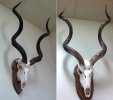BCHunter
AH member
- Joined
- Feb 22, 2013
- Messages
- 18
- Reaction score
- 0
- Media
- 1
- Member of
- BCWF, North Peace Rod gun Club
- Hunted
- RSA, Zambia
I had my 10 species of game mounted in South Africa. When they arrived back here in Canada, I was surprised that all the horns had turned completely BLACK.
Is this a normal thing to happen? Or is the taxidermist at fault?
I realize that it is too late to do anything about it now, but am going to Zambia this year and would like to avoud this happening again.
Would like the horns to stay their natural colour.
Is this a normal thing to happen? Or is the taxidermist at fault?
I realize that it is too late to do anything about it now, but am going to Zambia this year and would like to avoud this happening again.
Would like the horns to stay their natural colour.


